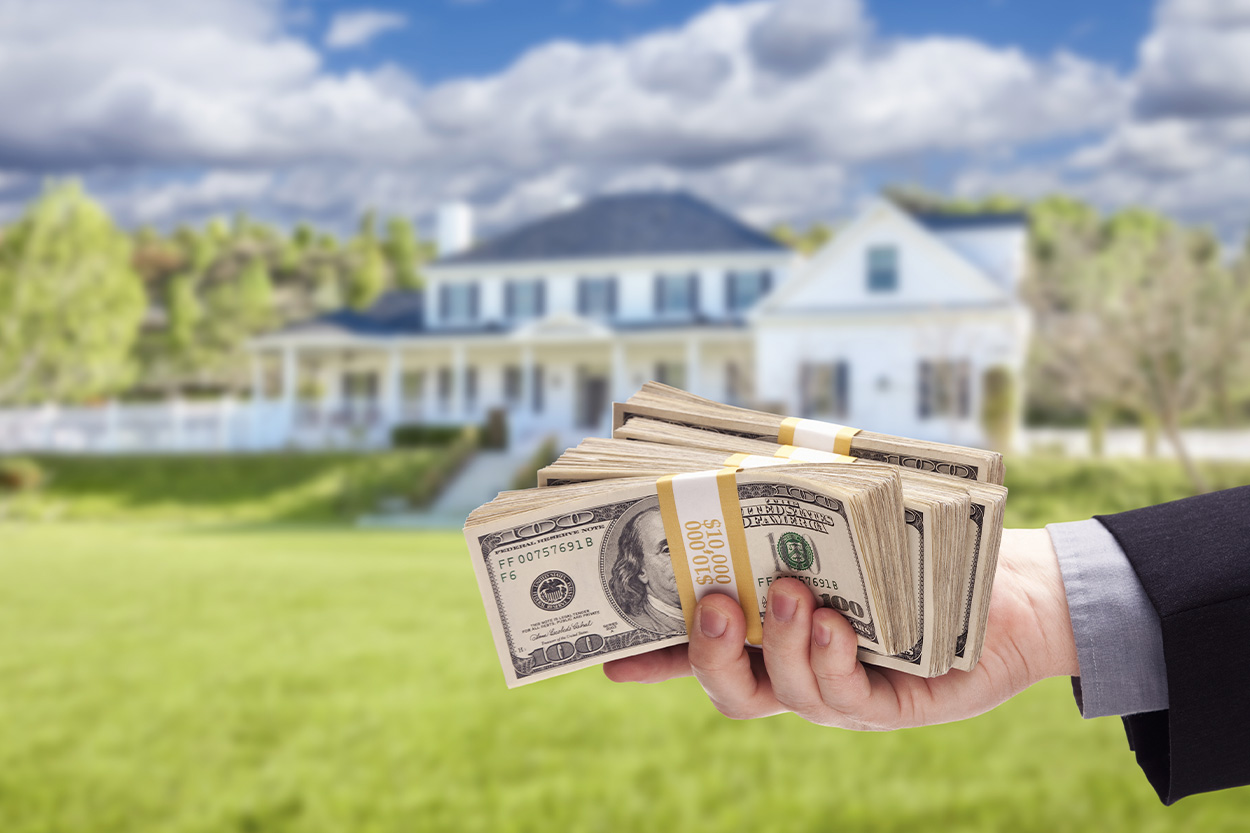How Much Money Should You Put Down On A House?

Key Takeaways:
- A down payment is a percentage of a home’s total purchase price that you pay upfront. Many real estate experts recommend putting 20% down on a house.
- While making a larger down payment has many benefits, such as receiving a lower interest rate, it’s not possible for every aspiring homebuyer. As a result, the average first-time homebuyer only puts down 7%.
- Each type of mortgage loan has slightly different minimum down payment requirements. As long as you meet your mortgage lender’s minimum requirements, the right down payment will depend on your financial situation.
How Much Money Should You Put Down On A House?
If you’re like most people, you probably can’t afford to buy a home outright with cash. After all, a home is one of the most expensive purchases you’ll ever make. Unless you have hundreds of thousands of dollars sitting in the bank, you’ll likely need to finance your home with a mortgage.
Even with a conventional mortgage, you usually still need to pay a percentage of the home’s price upfront in the form of a down payment. So how much money should you put towards your down payment?
Below, we’ll explain how you can choose the best down payment amount for your financial situation.
What is a Down Payment?

A down payment is the amount of money you pay upfront to purchase a home. Down payments are usually expressed as a percentage of a home’s total purchase price.
For example, let’s say you want to buy a home that costs $300,000. However, you only have $30,000 in savings that you can pay upfront. You use this $30,000 to make a down payment of 10% and finance the remaining 90% with a mortgage of $270,000.
A down payment represents your initial ownership stake in your new home. The rest of your home technically belongs to your lender until you pay them back. As you make monthly mortgage payments, your equity in your home will gradually increase until you own your home outright.
What is the Typical Down Payment on a House?
Historically, many real estate experts have recommended any home buyer make a down payment of 20%. If the home you want to buy costs $500,000, you would need to put $100,000 down to reach this 20% benchmark.
As you can see, a 20% down payment requires a substantial amount of savings, depending on the home price.
Fortunately, you don’t have to put down 20% if you don’t want to. The average down payment for first-time homebuyers is 7%. By making a smaller down payment, you can become a home buyer a lot sooner.
Should You Put 20% Down?
When you take out a mortgage loan, you have to pay interest on every dollar you borrow. Thus, the less money you borrow, the less interest you’ll have to pay in the long run. A larger down payment will also allow you to:
- Qualify for a lower interest rate
- Enjoy a less expensive monthly mortgage payment
- Have more equity in your home right away even as a borrower initially
Another benefit of making a 20% down payment is that you won’t have to purchase any mortgage insurance. Most lenders require you to buy mortgage insurance if you put less than 20% down. This insurance gives them extra financial protection in case you default on your mortgage payments in the future. However, mortgage insurance can cost a few hundred dollars a month, so you may want to avoid it by making a higher down payment.
While making a 20% down payment has its perks, it’s not feasible for every aspiring homeowner. Saving up 20% of a home’s purchase price could take years, depending on the home you want to buy. Fortunately, all you have to do is make the minimum down payment required by your mortgage lender.
What Are The Minimum Down Payment Requirements?
Each type of mortgage has slightly different minimum down payment requirements. Here are the most common types of mortgage loans and their down payment requirements:
- Conventional loans – Conventional loans are the most common type of mortgage loan. Depending on which lender you work with, conventional mortgages usually require a down payment of at least 3%. If your credit score is lower than 620 or if you have a lot of debt, your lender may require you to put down as much as 5 to 15%.
- FHA loans – FHA mortgage loans are backed by the Federal Housing Administration. These loans have lower financial and credit score requirements than conventional loans. If you use an FHA loan, you must put at least 3.5% down. However, if your credit score is below 580, you may be required to put as much as 10% down.
- VA loans – VA mortgage loans are only available to current and past members of the Armed Forces and National Guard. They are backed by the U.S. Department of Veteran Affairs. If you qualify for one of these government-backed loans, you can put as little as 0% down.
- USDA loans – USDA loans are backed by the U.S. Department of Agriculture’s Rural Development Program. These mortgage loans can only be used to purchase homes in qualified rural and suburban areas. If you use a USDA loan, you can put as little as 0% down.
As you can see, many mortgages allow for low-to-no down payments. These affordable down payment requirements make getting into the housing market a little easier.
How Much Money to Put Down on a Mortgage

With these minimum requirements in mind, you may be wondering what the ideal down payment is for your situation. While making a larger down payment can help you save money in the long run, a smaller down payment can help you buy a home sooner.
You can determine your ideal down payment amount by considering each of these factors:
- Home price – The more expensive your chosen home is, the more money you’ll need to put down to purchase the home.
- Your total savings – If you have a lot of money saved up, you can put it to good use by making a more substantial down payment. This larger down payment will help you save money on your mortgage in the long run, due to your decreased interest costs. Just make sure you keep enough savings in the bank to serve as an emergency fund.
- Your monthly cash flow – If you have limited savings but a steady income, you may be better off making a smaller down payment and taking on larger monthly mortgage payments. Just make sure you can comfortably afford your new mortgage rate with all of your other monthly expenses.
- Your new home’s condition – If the home you buy needs renovations or repairs, you may want to choose a smaller down payment. This way, you’ll have some savings left over to cover these additional expenses.
- Your age – If you’re close to retirement, you may want to make a larger down payment so you aren’t stuck with costly mortgage payments once you stop working.
As you can see, the best down payment depends on your unique financial situation. A down payment calculator can help you determine the ideal down payment for your upcoming home purchase.
Sources:
USA Today. Here’s some good news if you’re buying a home: cash is no longer king.
Consumer Financial Protection Bureau. How to decide how much to spend on your down payment. https://www.consumerfinance.gov/about-us/blog/how-decide-how-much-spend-your-down-payment/
NerdWallet. The 20% Mortgage Down Payment Is Dead.
https://www.nerdwallet.com/article/mortgages/the-20-mortgage-down-payment-is-dead
Consumer Financial Protection Bureau. Determine your down payment. https://www.consumerfinance.gov/owning-a-home/process/prepare/determine-your-down-payment/






